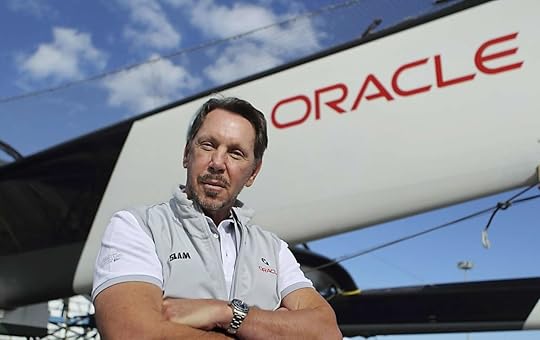Oh, That Larry Ellison
I interviewed Oracle CEO Larry Ellison in person just once, in 2002. The main things I have long remembered about it were that the room was dark, Ellison acted like he wished I’d go away, and he had two bodyguards, each looking like they could bench press a subway car.
The details of my time with Ellison only came back to me once I re-read the story that I wrote back then. I was reminded of how odd Ellison was – and in all likelihood still is, now that he’s good buds with Trump and working with his son, David, to control a sizable chunk of American media.
Even before I met Ellison, I didn’t much admire the kind of character he was on the tech scene. The short version is that he seemed to enjoy being something of tech’s Darth Vader. He had a reputation for publicly clashing with and/or sacking his own executives, trash-talking other tech companies’ CEOs, and hiring private investigators to find dirt on Microsoft CEO Bill Gates, even having them rummage through Gates’ trash and pay off Microsoft janitors for tips. Ellison considered Gates his arch-rival and seethed at Microsoft’s success – particularly that Microsoft had more success than Oracle.
“I still believe we’ll be the number one software company in the world,” Ellison told me in that shadowed room back then. “We’ll pass Microsoft.” Hm, well, Microsoft is worth $3.8 trillion. Oracle, about $823 billion. So that didn’t happen.
Here’s how I described Ellison in my piece: “Ellison is this peculiar mix of, on one side, a MiG-flying, America’s Cup-racing, babe-magnet zillionaire playboy; and on the other side, a geek who can get excited about improving Web server response time by a few microseconds.”
I was disappointed, as a journalist, that I got the latter. He wanted to tell me all about software called clustering that was going to make Oracle’s databases more reliable. “It’s a huge breakthrough in computer science,” he said, and apparently it was, though for the general public that revelation was about as exciting as hearing of a new kind of automobile suspension system.

I also noted in the story: “Ellison once broke his neck surfing, then broke his arm in 28 places in a biking accident while recovering from breaking his neck. He almost died in a sailing incident a couple of years ago, and now he’s bought a boat so he can compete in the next America’s Cup yacht race.” Some people admire that kind of thing. Oracle shareholders no doubt didn’t much appreciate their CEO constantly middle-fingering death.
My interview with Ellison was arranged by his PR people, for right after he gave a speech to a tech industry group. So first I attended the speech. He used it to again poop on Microsoft.
“If you really want 50 machines that break all the time and require lots of labor, go with the guys in Redmond,” Ellison said on stage. (Just in case you don’t know, Microsoft has long been headquartered in Redmond, Wash.) Then he knocked IBM for following Microsoft’s technological path. “It must have been the unreliability that appealed to them,” Ellison said of IBM.
Once the speech was over, I was to meet Ellison backstage to talk. That’s when I encountered the bodyguards, who as soon as I walked in bolted to get between me and Ellison. They only let me pass once the PR person said, “He’s OK.” As I wrote: “For a couple of minutes, it’s like I’ve entered a Sopranos episode.”
Anyway, now it’s 23 years later. Ellison is 81, having outlasted his physical recklessness. He’s worth about $365 billion, so on one measure he’s whipped Gates, who today is worth around $105 billion. Oracle is back in the headlines because of its relationship with OpenAI and the Ellison family’s control of Paramount Skydance.
And, apparently, these days all the rich tech people have bodyguards. I didn’t realize that Ellison was ahead of the curve on that one.
“As I get up to go, it seems for a moment like there are two Larry Ellisons,” I wrote at the conclusion of my story. “There’s the crazy cartoonish version for public consumption, which he left onstage. And there’s this one in the back room, who seems quite a bit more human and far less outrageous. I’m not sure which one is more real.”
Still don’t know.
—
This is the article as it originally appeared in USA Today on February 13, 2002.




